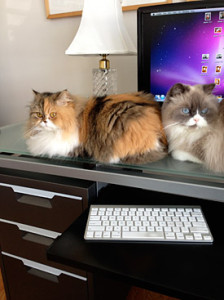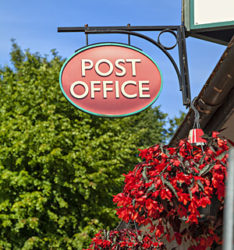
Despite the accelerating demise of the personal, handwritten letter, the art of bread and butter letters and thank you notes appears to have continuing life. Expressing gratitude sometimes can be difficult, but even a brief note of thanks is always welcome, and one of the most meaningful and important communications we undertake.
While social usage evolves over time, good manners are timeless. In Your Best Foot Forward: Social Usage for Young Moderns (McGraw Hill Book Company, Inc., c. 1940) by Dorothy Stratton and Helen B. Schleman, the authors advise that “You are expected to write a thank-you note on the following occasions: 1) After you have been a guest overnight; 2) After you have received a gift or remembrance of any kind from a friend whom you may not have the opportunity to thank in person; and 3) After anyone has shown you any particular courtesy, as for example, after a person in another city has shown you through …a museum or other place of interest.” While a written note to give thanks for a being a guest at a dinner party or luncheon is not required, acknowledgement by phone or in person is a necessity.
One has to wonder how Mesdames Stratton and Schleman would feel about using email for extending a thank you note. According to the current online Emily Post Etipedia: “The reality of email thank-you’s, much like email itself, is a degree of emotional distance: an email to your grandmother is simply not as personal as a note written in your own hand. So if you have a casual relationship with the gift giver and you correspond via email regularly, an email thank-you may be appropriate. For most other people, the written thank-you is your best bet for an expression of warm, heartfelt thanks. The last thing you want is for someone to be disappointed when her hand-knit scarf is acknowledged with a loud, animated e-card.”
In short, social etiquette, when it comes to extending thanks via a hand written note, has not changed all that much. Many early 20th century letter writing books, such as Complete Letter-Writer for Ladies by Ward Lock (Ward Lock & Co., London, n.d.); The Etiquette of Letter Writing (Eaton, Crane & Pike Co, 1927); and The Art of Letter Writing by A Society Lady (originally published by Foulsham & Co., 1918 and republished by the Bodleian Library, 2014), focus on giving specific examples or templates for letters, covering a wide variety of topics. Society Lady, for example, provides a template for “From a Lady to a Gentleman, asking him to refrain from Further Attentions.” Ward Lock provides an example of how to “Answer to an Invitation Negatively.” And, like many other letter-writing books of the early 1900s, Eaton, Crane and Pike offer advice on addressing people of title.
The concept of letter writing templates dates back even earlier. What Shall I Say? A Guide to Letter Writing for Ladies (James Bowden, London, 1898; republished by Pryor Publications, Kent, England, 2004) is even more specific. “The notepaper should always be clean. A woman who uses soiled notepaper must not complain if her correspondent suspect (sic) her of being slovenly and untidy.” The book advises and gives templates for writing letters to one’s husband, daughter, son, aunt, and other close relatives. It goes on to give advice on how to write a letter delaying a marriage, and more.
In answer to a proposal from a man who is a flirt, the following is suggested: “Dear Sir: You may not be aware that Miss Watson is a great friend of mine, and that in consequence, I read your last letter to her in March last. It was infinitely amusing to find the same expressions repeated in your letter to me that you had used to her. I wonder how many more such letters you have written? Please do not reply to this, as I have no wish to hear of or from you again.”
Ouch. Harsh. But, indeed, what a cad.
Modern day advice on letter writing tends to be more fluid, with the emphasis on making the note or letter a personal expression, rather than following a template. In The Art of Personal Correspondence, by Margaret Shepherd with Sharon Hogan (Broadway Books, 2008), the authors note, “There’s no uniform rule for how to send which words, when, and to whom. As in all art, the ideal makes compromises with the real.”
The general rules are fairly easy to remember. Acknowledge the giver, mention the gift, and include some detail about the way the gift will be used, and its value to you, the recipient.
In my personal correspondence, I customarily start a thank you note or letter with something other than “thank you very much for the (fill in the blank).” Instead, I try to start out with some context about why a particular gift is special to me, whether by describing an activity, a recent trip, a visit to the museum, etc. that demonstrates the relevance of the gift. When appropriate, I like to write about the perceptiveness of the giver for having found the perfect gift, whether it is a special lunch or dinner, a box of beautiful note cards, or a book with personal meaning.
It now has been four months since socialcorrespondence.com was launched, which brings to mind the gratitude I feel for each of its readers. Through Social Correspondence, I have received advice and good ideas from current and long-time friends, reconnected with old friends, and met new friends with shared interests. This seems to be an appropriate time to extend special thanks to all of you who have been making suggestions and letting me know that this publication is of interest to you. Thank you!
Many of you have helped me to visualize the blog and have shared good ideas for interesting topics, as well as books, especially Susan, Evette, Ann, and my husband Murray, here in San Francisco, as well as Nancy, in Honolulu. I am grateful to those of you who have encouraged other readers to join the discussion, including Carol Ann, as well as Katherine, who introduced Social Correspondence to Ian Jackson, rare and antiquarian bookseller in Berkeley, CA. Not only has Ian shared treasures from his own research on letter writing, but also he recently facilitated a gift to me, a book titled Century of the Typewriter, by Wilfred A. Beeching (British Typewriter Museum Publishing, 1974), a book that was once part of the personal library of former typewriter repairman Manson Whitlock, the subject of my first post. For this gift, I thank Basie Gitlin of Whitlock Farm Booksellers. If you love used and rare books, do visit Whitlock Farm Booksellers (originally owned by a brother of Manson Whitlock) at 20 Sperry Road, Bethany, CT.
Thank you also to those of you who have helped me with research, including Sarah and Byron of Readers Bookstores, San Francisco, Ft. Mason and Main Library; and the San Francisco History and Book Arts and Special Collections Center of the San Francisco Public Library, especially Susan, Andrea, Tim and Lisa. Most especially, thank you to all the readers of Social Correspondence. Please stay in touch with your continued comments and letters




Dorothy
7 Jul 2014And we thank you, too, Marcia! “Social Correspondence” is always a delightful surprise when it lands in my cluttered inbox. (I had to train Yahoo in the fine art of recognizing it; silly spam-filter kept thinking that the messages were unwanted. Not so.)
I love to buy original notecards from local artisans in both Port Townsend and Berkeley. After purchasing them, I put them away in why passes for a filing system. (Okay, so its a paper bag in my junk drawer.) The fun part is selecting the right card to send out as a thank you. Usually, one of the set will raise its pretty little face to announce that it wants to be chosen. “Me next, I’m next send me.”
The card becomes my personal emissary for its originality. And I rarely have to stumble over what words to write. “Thank you for the ….” is quite adequate. Still looking for just the right occasion to send out my beautiful “lemon branch” card, though. Somehow, implying that I received a lemon as a gift is, well, potentially fraught with danger.
Cheerio, good to chat. And once again, thanks!
Marcia Schneider
7 Jul 2014Hi, Dorothy and Sandra,
Once again the postcard idea turns up. I have started collecting them now too, thanks to your good suggestions! It’s so easy to write a quick note, so fun to select, and so fun to receive!
sandra drissen
7 Jul 2014I have to say I especially enjoyed the photo appearance of Autumn and Percy as overseers of this well done entry. Meowsa, Sandra
Anne Roughton
8 Jul 2014Many years ago I sent off for a 28-page booklet How to Write Letters for All Occasions by Abigail Van Buren (aka Dear Abby). I still keep it tucked up next to my postage stamps. She advises : “Your thank-you message should be written by hand, unless you handwriting is so bad it’s either illegible or a terrible chore for the writer (arthritis), in which case the typewritten note is acceptable.”
Marcia Schneider
9 Jul 2014Hi, Anne,
I also bought that booklet recently, but unfortunately, it hasn’t been updated since 1981! I guess I can consider my copy “vintage”
Jewelle
8 Jul 2014I compulsively buy blank cards that look unusual or unique and keep them for notes of thanks. I used to feel it was beginning to be self-indulgent…the pleasure of discovering some new card to bring home is so great! But more and more it’s become so special to receive actual thank you cards, or cards of any kind; so I think I’m less self indulgent than eager to surprise.
Marcia Schneider
9 Jul 2014Ah, Jewelle. My kindred spirit. I too buy blank cards. Sometimes I think it is getting out of hand, so I am becoming more selective. For all my San Francisco friends, try Dandelion on 14th and Potrero. What are your favorite places to find unique and fun cards?
Mollie
8 Jul 2014Writing thank you notes have been ingrained in me from a very early age… I wonder why! I will incorporate some of these ideas into the many thank you cards I’ll be writing soon!
Ed McBride
11 Jul 2014This is a wonderful post as all of your post have been since you started Social Correspondence. Each one has brought to me a great memory from my past and this one is no exception. I too was taught at an early age the importance of a thank you note and though I don’t always remember to send a note (I have no excuse I know) I am reminded when I do receive one myself and how it makes me feel that these simple acts are truly one of life’s social graces. I also laugh and offer a lighthearted reference to the book A Southern Belle Primer: Why Princess Margaret Will Never Be a Kappa Kappa Gamma which as a Southern gentlemen was sent to me by some very dear friends many years ago. In the Primer a Southern Belle is reminded to take her thank-you cards with her completely written and ready to drop in the mailbox as she leaves a social event to be sure her host and hostess are promptly notified of the wonderful time she had at their home. So Mollie imagine being taught about social graces and thank you notes by a very long line of Southern Belles!
And by the way Marcia, thank you for a lovely lunch this afternoon and for another wonderful post!
Marcia Schneider
11 Jul 2014Dear Ed,
What a lovely reply. thanks for being such a great friend and the most perfect gentleman! thank you!